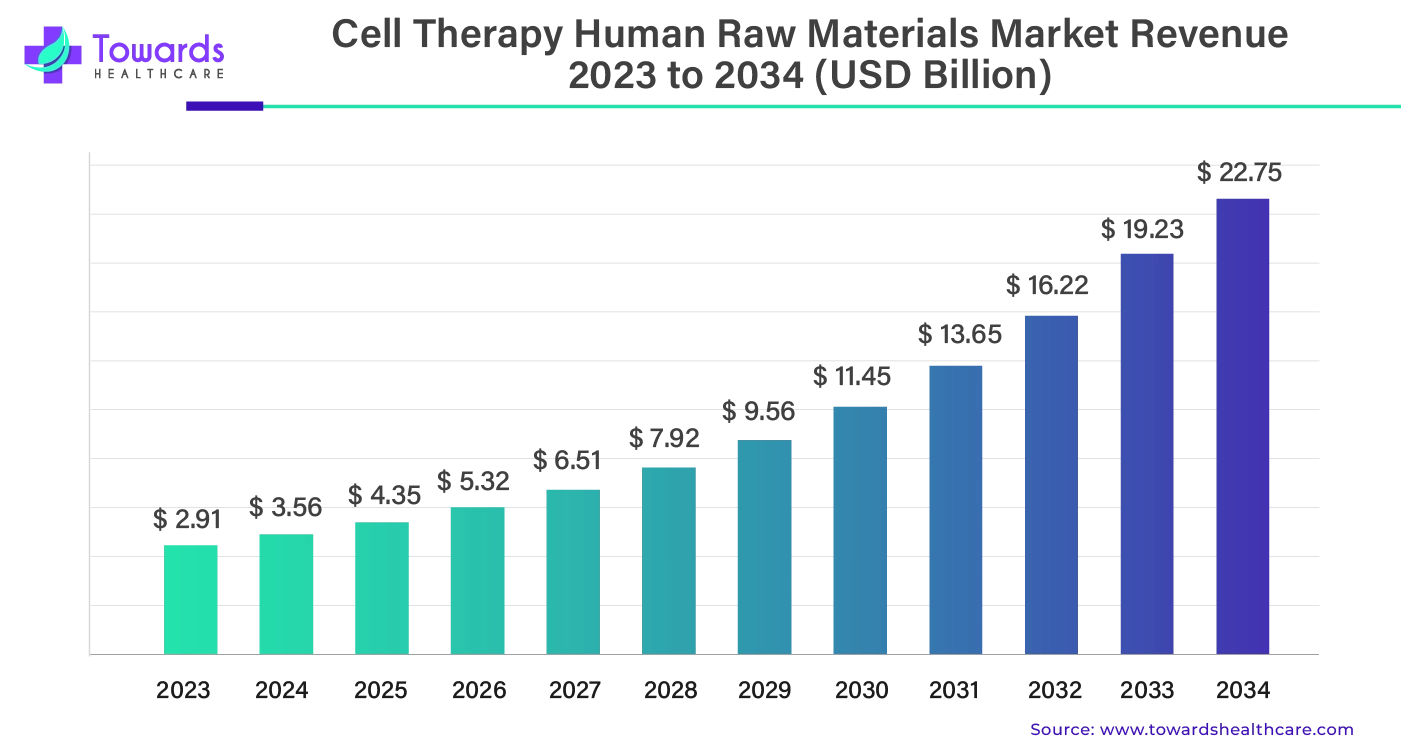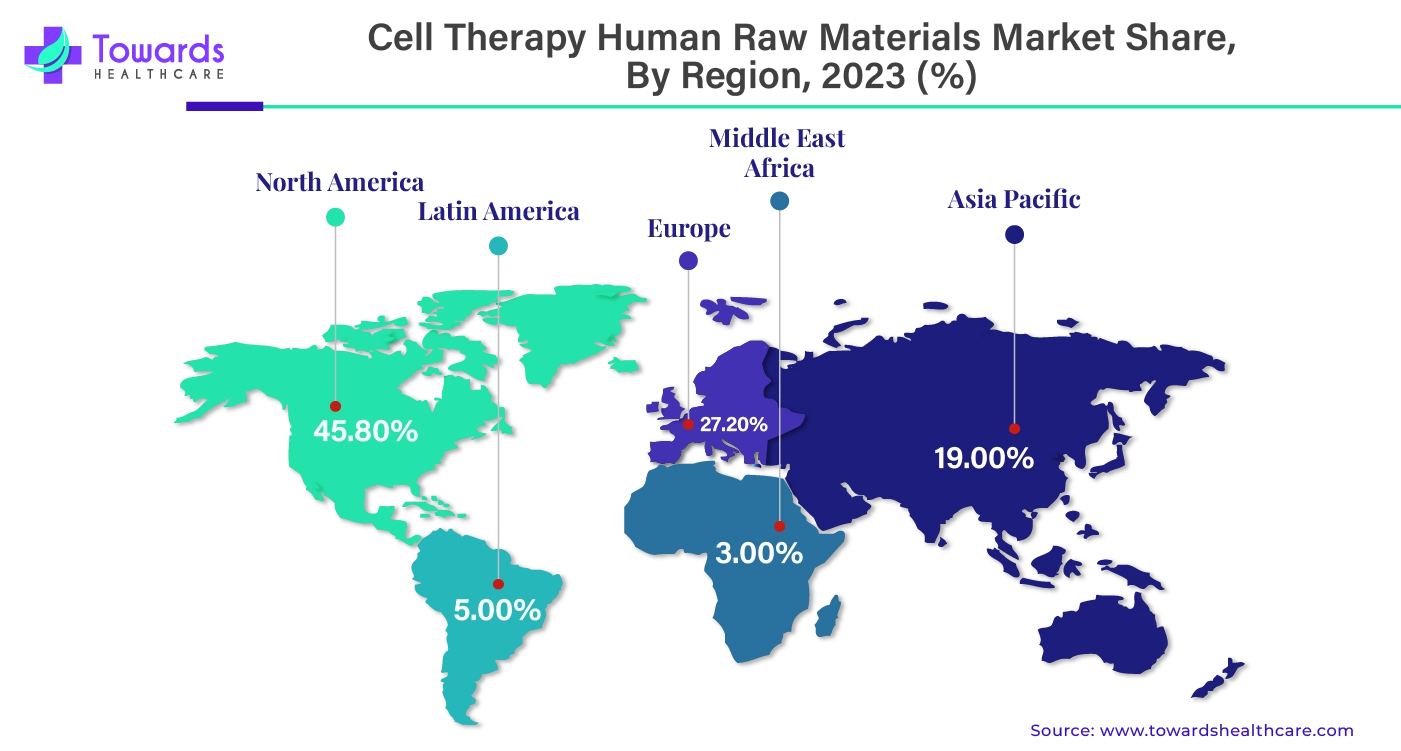April 2025

The global cell therapy human raw materials market size was estimated at US$ 2.91 billion in 2023 and is projected to grow to US$ 22.75 billion by 2034, rising at a compound annual growth rate (CAGR) of 22.38% from 2023 to 2034. The growing demand for personalized medicine increases the demand for human raw materials required in cell therapies.

Cell therapy has become a very exciting area of study with novel therapeutic possibilities for a variety of illnesses. Although human cells are essential components for producing products for cell therapy, they frequently bring about a great deal of variability. On the other hand, the optimal collection of high-quality, consistent cellular material is made possible by strict operational controls and quality systems. The functioning of raw materials employed in cell therapy must enable desirable cellular activity. This covers the survival, differentiation, and multiplication of cells. It is crucial to choose raw materials that are suitable for the targeted therapeutic applications and the particular cell types.
The immense potential of artificial intelligence in healthcare is demonstrated by the industry's rapid expansion and large investments in R&D. The industrial industry is expected to face a financial effect of $3.8 trillion by 2035, while the AI market is predicted to reach an astounding $407 billion by 2027. The healthcare sector has been the most heavily invested in, with an estimated $6.1 billion in 2022. Over the past ten years, artificial intelligence (AI) and machine learning (ML) predictive techniques have transformed various biological domains, such as genome annotation, protein structure prediction, and synthetic enzyme design. By applying these predictive techniques to the creation of cell treatments, it may be possible to create better cell therapies more quickly and with fewer resources.
For instance,
| Company Name | REPROCELL |
| Headquarters | Kanagawa, Japan, Asia Pacific |
| Recent Development | In May 2024, REPROCELL generated human-induced pluripotent stem cells (hiPSCs) that were therapeutically relevant by managing the donor recruiting process for seed stock hiPSCs and ensuring donor eligibility with several regional regulatory bodies. Strict selection is applied to the raw materials, and a patented technique for footprint-free RNA reprogramming is employed. In order to produce hiPSC and hMSC that are appropriate for therapeutic application, REPROCELL has recently expanded this offering by purchasing a Cytocentric Xvivo system model 2 from BioSpherix, which is a closed GMP cell culturing system. |
| Company Name | Pluri Inc. |
| Headquarters | Haifa, Israel, Middle East |
| Recent Development | In January 2024, the biotech company Pluri Inc. introduced PluriCDMO, a new business division that provides contract development and manufacturing organization (CDMO) services for cell therapy production. From its cutting-edge, 47,000-square-foot GMP cell therapy production facility, PluriCDMO will provide development and manufacturing services to assist clients in overcoming significant obstacles in the creation and manufacture of cell-based medicines. |
The cell therapy human raw materials market is growing due to the growing demand for personalized medicines due to various genetic, autoimmune, and chronic conditions along with cancer. These diseases require personalized medicines for better quality of care and better health outcomes. During cell therapy, the genetic material of an individual is used along with environmental conditions and lifestyle to develop better cell therapies, which will require human raw materials from individuals for testing and other purposes.
One of the biggest obstacles is the inherent danger of contamination and unpredictability in human raw ingredients. Striving for repeatability in cell treatments requires maintaining consistency in cell quality and features. Therefore, possible obstacles such as contamination and variability exist.
Further investigation into other cell sources, such as hematopoietic stem cells (HSCs), induced pluripotent stem cells (iPSCs), and mesenchymal stem cells (MSCs), among others, offers a chance to grow the industry. Cell treatments may be made more versatile and applicable by investigating and adding novel cell types.
There are currently close to 400 million rare illness patients globally as the frequency of these conditions rises yearly. Certain malignancies and uncommon disorders may be treated or even cured with cell and gene therapy (CGT). There may soon be a surge of novel gene treatments available. Over the next five years, it is anticipated that the CGT will almost triple. The numerous qualities of cell/gene therapy make it a wise option for treating uncommon ailments. Once mastered, replacing or repairing damaged genes is a highly reproducible strategy that may be used to treat a wide range of genetic illnesses.
For instance,
By product, the cell culture supplements segment held the largest share of the cell therapy human raw materials market in 2023. With the use of cell culture supplements, labs can modify and enhance media formulations to meet the needs of certain cell culture applications, including the creation of proteins, hybridomas, Chinese hamster ovary (CHO) cells, various serum-free processes, and more. The supplements evaluated in cell culture and insect culture that are gathered here have been applied and tested to ensure that they work well in cell culture systems. Many culture parameters, including the right medium composition for your cell line, are critical to ensuring proper cell development. Basal or complex media can be improved and supplemented with lipids, vitamins, amino acids, serum, and antibiotics to assist cell development.
For instance,
By product, the cell culture media segment is anticipated to grow at the fastest rate in the cell therapy human raw materials market during the forecast period. For the purpose of supplying the elements required to sustain cell growth and function, cell culture media is essential. The nutrients and growth factors your culture environment needs for the cells to behave as predicted are provided by components in the cell culture medium. Furthermore, media may be designed to control pH and osmotic pressure, two other environmental factors in cell growth. Different formulations of cell culture medium have been created to accommodate a broad range of cell types and experimental uses.
For instance,
By end-use, the biopharmaceutical & pharmaceutical companies segment dominated the cell therapy human raw materials market in 2023. Cell and gene therapy is being used by pharmaceutical corporations to treat complicated medical diseases and expand treatment alternatives. Pharmaceutical corporations are strategically investing in cell and gene therapy in addition to concentrating on innovation to expand their patent portfolios. The goal of these expenditures is to put oneself at the forefront of industry innovations and close profitable partnerships with partners. A few of the most recent agreements highlight the significance of gene and cell therapy for the pharmaceutical sector.
By end-use, the CROs & CMOs segment is expected to showcase the fastest CAGR in the cell therapy human raw materials market during the predicted period. Biotechnology and pharmaceutical businesses frequently turn to third-party suppliers for development and manufacturing help, most frequently to CROs, CMOs, or CDMOs, in order to manage industry challenges and fill resource shortfalls. Both bio/pharma businesses and CDMOs continue to invest in the development and manufacturing capabilities for cell and gene treatments, which represent a niche but expanding industry on a product basis. Due to the industry's limited capacity for these novel modalities, CDMOs of all sizes continue to make investments in research and development as well as production capacity.

By region, North America dominated the cell therapy human raw materials market share by 45.80% in 2023. The region's dominance may be attributed to supportive government policies, an increasing need for innovative treatments, and coordinated efforts by significant industry players to improve cell therapy products that treat a range of chronic illnesses. Furthermore, North America is home to a large number of well-known businesses that produce and sell cell-based goods, which is driving up demand for human raw materials for cell therapy and further expanding the market. Moreover, joint ventures between major industry participants and smaller biotechnology enterprises intensify rivalry as firms endeavor to strengthen their positions in the constantly changing cell therapy sector.
For instance,
By region, Asia Pacific is expected to grow at the fastest rate during the forecast period. The rise in demand for advanced cell treatments and the heightened emphasis on biotechnology are the reasons for this surge. The market is growing because of the establishment of manufacturing facilities, strategic partnerships, and increased R&D activity by major industry players. Additionally, the Asia-Pacific region's highest market share belonged to China's Cell Therapy Human Raw Materials market, while India's Cell Therapy Human Raw Materials market grew at the quickest rate.
| CAR-T Cell Therapies Approved in Asia | |||
| Brand | Manufacturer | Country | Year of Approval |
| Carvykti | Legend Biotech, J&J | Japan & South Korea | 2023 |
| Yuanruida (CNCT19) | JUVENTAS | China | 2023 |
| Carteyva | JW Therapeutics | China | 2021 |
| Fucaso | IASO BIO, Innovent | China | 2023 |
| Saikaize (Zevor-cel) | Carsgen Therapeutics | China | 2024 |
| Abecma | BMS, bluebird bio | Japan | 2022 |
| Breyanzi | BMS | Japan | 2021 |
| Yescarta | Kite Pharma, Fosun Kite | Japan & China | 2021 |
| Kymriah | Novartis | Japan, South Korea and Taiwan | 2021 |
By Product
By End-Use
By Region
April 2025
April 2025
April 2025
April 2025